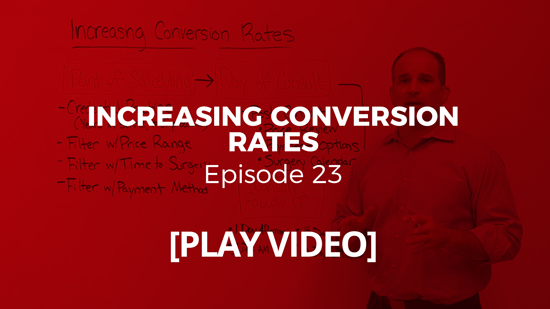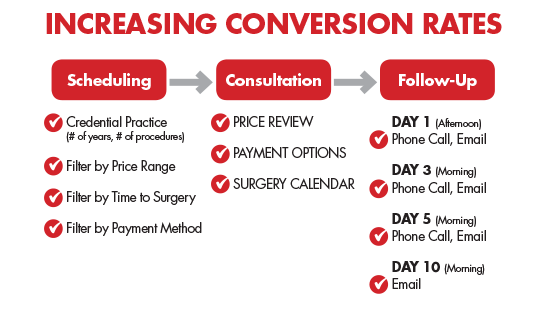To increase patient conversion rate and better a patient’s experience at your practice, we recommend paying attention to what you address at three critical times.
Point of Scheduling
Assuming you’re managing your leads appropriately, when you schedule your consultations you should be filtering out clients who have a genuine interest in your business. You don’t need to spend thousands of dollars a month to learn how to sell your practice.
Before your consultation, your potential patients should know how many years you have been in service and how many procedures you’ve completed (with respect to what the client is interested in).
You should key in on a handful of things to tell an interested consumer about, to get them excited to have a consultation with you. These can be different for each procedure, but make sure you credential every consumer who inquires about the practice.
It’s also a good idea to filter clients by the price range of your services before you put them on the calendar. You don’t want to bring in a patient for a $6,000 procedure who only has a $3,000 dollar budget.
It’s better to provide the client with a price range that gives you the flexibility to work with the consumer to build them a procedure that fits their price point.
Next, ask the patient when they want to have their procedure done. If they want it immediately, try and fit them in for a consult as soon as possible. If they want to have the procedure in a year, you don’t have to worry about scheduling them until a couple of weeks down the road based on the availability of their calendar. You also need to ask them how they’re going to pay for the procedure. This will help you set up your calendar as productively as possible.
Consultation Day
After the consultation process, your patient coordinator and you, as the physician, need to go over the exact price for the patient’s procedure so there aren’t any surprises later on. You should have already discussed the price range and payment options with the client, and they should now be on your surgery calendar.
If the client is still hesitant about the cost of the procedure or if they haven’t scheduled a date for the surgery, you need to follow up with them quickly and consistently.
Follow-Up
We recommend even following up with them later that day. You don’t want to potentially lose your client to the competition. If they still haven’t scheduled on the day of the consultation, follow up on the day after and then three days later by both phone and email. If none of these contact attempts are successful, move them to your email marketing list.

















